PT
A Rua
"Este arruamento das freguesias de Santo António e de Arroios, que liga a Alameda de Santo António dos Capuchos à Rua da Cruz da Carreira, foi atribuído pelo Edital de 12/08/1982 à Rua da Alameda, que antes (até à publicação do Edital municipal de 18/12/1893) era a Rua de Rilhafoles, por memória da Quinta local com o mesmo nome. O Atlas da Carta Topográfica de Lisboa de Filipe Folque, de 1858, já menciona o Hospital e a Quinta de Rilhafoles."
"Com a legenda «Médico/1903 – 1960» foi fixado na memória de Manuel Almeida Amaral (Lisboa/1903 – 15.05.1960/Lisboa), um médico formado pela Faculdade de Medicina de Lisboa (1926) com a tese de licenciatura «O Tratamento Cirúrgico das Doenças Mentais – Contribuição para o Estudo dos Resultados Terapêuticos e Leucotomia Pré-Frontal» e que mais tarde, em 1944, concluiu um doutoramento e se dedicou à Psiquiatria.
Trabalhou como Médico da Armada, sendo chefe de neuropsiquiatria do Hospital da Marinha a partir de 1933 e, instituiu a selecção psicotécnica na admissão dos futuros marinheiros. Discípulo de Sobral Cid, frequentou as mais importantes clínicas da especialidade em França, Espanha, Suíça, onde estudou a aplicação da ergoterapia nos hospitais de doenças mentais.
Foi ainda, a partir de 1945 e até ao ano do seu falecimento, diretor do Hospital Miguel Bombarda, estrutura hospitalar nascida em 1848 como Hospital de Rilhafoles, por se situar na Quinta de Rilhafoles, onde imprimiu profundas transformações que muito melhoraram as condições de hospitalização e o tratamento dos doentes. É na sua gestão que o Hospital muda de nome para Hospital Miguel Bombarda, se autonomiza do Hospital de São José e, são feitas comemorações do centenário (1948) com obras de recuperação das instalações.
Refira-se ainda que o Dr. Almeida Amaral foi assistente da cadeira de Psiquiatria, em 1927, na Faculdade de Lisboa e, Presidente da Sociedade Portuguesa de Neurologia e Psiquiatria." in topominialisboa
Segundo consta, mas ainda sem forma de confirmar, Almeida Amaral morreu por asfixia, engasgado com um pedaço de carne.
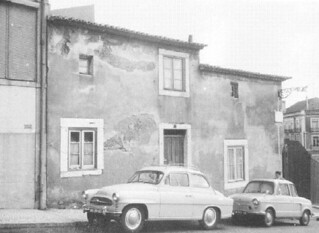
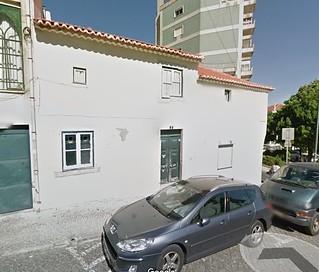
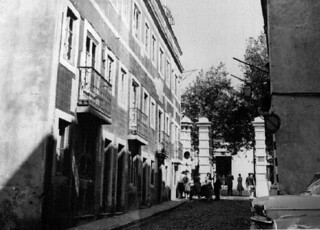
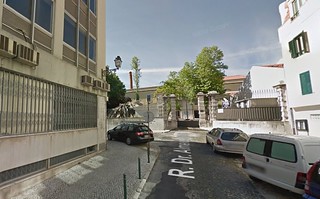
EN
The Street
"This street layout of the parishes of St. António and Arroios, which connects the Alameda de Santo António dos Capuchos to the Rua Cruz da Carreira, was assigned by the Edict of 8/12/1982 as Rua Alameda, previously (until the publication of municipal Notice of 12.18.1893) was Rua de Rilhafoles, in memory of the local farm with the same name. the Atlas Charter Topographic Lisbon </ em> Filipe Folque, 1858, as mentions the Hospital and the Farm Rilhafoles."
"With the legend "Médico / 1903 - 1960" was established in memory of Manuel Almeida Amaral (Lisbon / 1903 - 15.05.1960 / Lisbon), a physician graduated from the Faculty of Medicine of Lisbon (1926) with the thesis degree "The Surgical treatment of Mental Disorders - Contribution to the Study of Therapeutic Results and Leucotomy Pre-Front "and later, in 1944, he completed a doctorate and dedicated to psychiatry.
He worked as a navy medic, being head of the navy hospital neuropsychiatry from 1933 and established a psychological aptitude selection in the admission of future sailors. He also attended the most important clinical specialty in France, Spain, Switzerland, where he studied the application of occupational therapy in mental hospitals.
It was also, from 1945 until the year of his death, director of the Hospital Miguel Bombarda, born hospital structure in 1848 as Rilhafoles Hospital, as it is in Farm Rilhafoles where printed profound changes that much improved hospital conditions and treatment of patients. It is in managing the Hospital changes name to Miguel Bombarda Hospital, becomes autonomous Hospital of St. Joseph and centennial celebrations are made (1948) with restoration work of the facility.
It should be noted also that Dr. Almeida Amaral was an assistant psychiatry chair in 1927 at the Faculty of Lisbon and President of the Portuguese Society of Neurology and Psychiatry "in topominialisboa
According to reports, but still no way to confirm, Almeida Amaral died by suffocation, choking on a piece of meat..
#####################
O Convento / Hospital

Estamos na Colina de Santana, onde entroncam a Rua da Cruz da Carreira, a Rua Padre Luís Aparício e a Rua Dr Almeida Amaral, e podemos encontrar o portão de acesso ao Convento Rilhafoles, vicentino, que pertencia à Congregação da Missão, fundada por São Vicente de Paulo, foi fundado por autorização pontificia (Breve de 1717-09-10) e do Patriarca D. Tomás de Almeida (alvará de 1717-01-14). Também conhecido por: Casa da Congregação da Missão em Lisboa; Casa da Congregação da Missão em Rilhafoles; Casa de São João e São Paulo; Casa de Rilhafoles; Casa da Cruz de Lisboa.
Após a extinção das ordens religiosas em Portugal, o edifício do ex-convento de Rilhafoles albergou o Real Colégio Militar, a partir de 1 de Setembro de 1835, instituição que ocupou as instalações até que, por decreto de 14 de Novembro de 1848, referendado pelo duque de Saldanha e barão de Franco, foi transferido para o edifício do Convento de Mafra, por ocasião das reformas legislativas do ensino e do exército realizadas na época.
Em 1853 é construído o Edifício do Balneário, inaugurado pela rainha D. Maria II, para banhos terapêuticos aplicados em psiquiatria, considerado o melhor da Europa
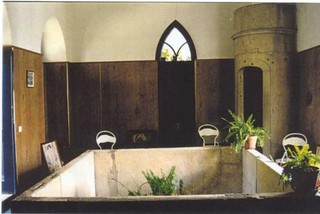
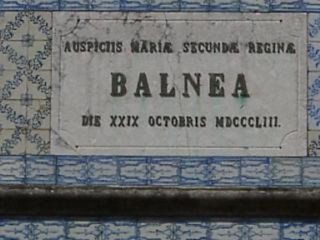
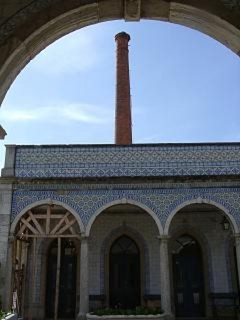
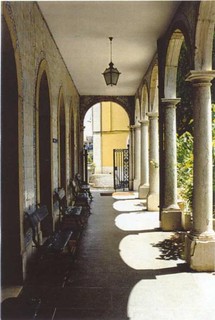
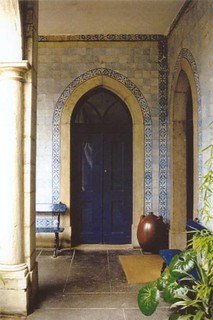 [2].
[2].
Após a nomeação do Prof. Miguel Bombarda para Diretor do Hospital, em 1892, são construídoe e inaugurados outros edifícios de excepcional valor arquitectónico e histórico. Da autoria do Arq.º José Maria Nepomuceno, o Edifício das Enfermarias em Poste Telefónico (1886-1894), o Pavilhão de Segurança (1892-1896) para doentes vindos da Penitenciária, que é um edifício único e vanguardista[3] em termos internacionais, revelado em 2009 pelo estudo de Vítor Albuquerque Freire, que antecipa em 30 anos o design e a arquitectura moderna das décadas de 1920 e 1930, (arredondamentos de arestas racionalistas generalizados em bancos, portas e janelas, para evitar contusões, proporcionar maior resistência e facilitar a limpeza) e um dos seis edifícios deste género (sistema inventado por Jeremy Bentham) no mundo e o único com pátio a descoberto (para os doentes permanecerem ao ar livre durante o dia, melhorando o seu estado de saúde e evitando a transmissão de doenças)[4].
A instituição evoluiu entretanto para o actual Hospital Miguel Bombarda, em homenagem a este médico psiquiatra, Grande-Oficial da Ordem de Benemerência a 29 de Novembro de 1948,[5] mas hoje encerrado.
Actualmente alberga o Museu Miguel Bombarda, de Arte de Doentes e Neurociências, com a maior coleção do país de arte outsider ou art brut, "arte pouco ou não influenciada pela arte institucionalmente aceite, produzida geralmente por autores sem formação ou autodidatas, desligados, pelo seu isolamento ou atitude, dos circuitos culturais, em muitos casos artistas com perturbação mental ou afastados e não reconhecidos pela sociedade"[6]. Nas visitas guiadas podem observar-se o Gabinete onde o Prof. Bombarda foi assassinado em 1910, a Igreja rocaille, o salão nobre e o Balneário D. Maria II.
Fica ao cimo da Rua Dr. Almeida Amaral, próximo da Rua de Gomes Freire, na zona do Campo dos Mártires da Pátria
Os edifícios do Balneário D. Maria II (1853) e o Pavilhão de Segurança (1896) foram classificados como Conjunto de Interesse Público (CIP) em 24 de Dezembro de 2010, e a sua zona especial de proteção integra todos os edifícios do Hospital.
Em Outubro de 2014, o edifício principal (antiga Casa da Congregação da Missão de São Vicente de Paulo) ficou abrangido pela classificação já existente para o Balneário D. Maria II e Pavilhão de Segurança do Hospital, estando em Vias de Classificação (como Conjunto de Interesse Público).[7]
Actualmente muita expeculação existe em torno deste espaço imobiliário e muitas dúvidas permanecem para o futuro.
EN: The Convent / Hospital
We are in Santana Hill, where three street meet: Rua Cruz da Carreira, Rua Padre Luis Aparicio and Rua Dr Almeida Amaral, and we can find the access gate to Rilhafoles Convent, vincentian, who belonged to the Mission Congregation, founded by St. Vincent de Paul was founded by pontifical approval (Brief 09/10/1717) and Patriarch D. Tomás de Almeida (14/01/1717 permit). Aka: Congregation of the Mission House in Lisbon; House of the Congregation of the Mission in Rilhafoles; House of St. John and St. Paul; House Rilhafoles; House of the Lisbon Cruz.
After the extinction of the religious orders in Portugal, the building of the former Convent of Rilhafoles housed the Royal Military College, from September 1, 1835, the institution which occupied the premises until, by decree of November 14, 1848, countersigned by the Duke of Saldanha and Franco baron, he was transferred to the building of the convent of Mafra, during the legislative reforms of education and the army carried out at the time.
In 1853 is built the bathhouse building, opened by Queen Maria II for therapeutic baths applied in psychiatry, considered the best in Europe
Following the appointment of Prof. Miguel Bombarda as Director of the Hospital in 1892, is built and opened other buildings of exceptional architectural and historic value. Designed by the Arq.º José Maria Nepomuceno, the building of the Wards in Dial Post (1886-1894), the Security Pavilion (1892-1896) to welcome patients in the penitentiary, which is a unique and avant-garde building internationally, revealed in 2009 the study of Vítor Albuquerque Freire, who anticipates in 30 years design and modern architecture of the 1920 and 1930s, (rounding rationalists edges widespread in banks, doors and windows to prevent injuries, provide greater resistance and facilitate cleaning) and one of six buildings of this kind (system invented by Jeremy Bentham) in the world and the one with the outdoor patio (for patients remain outdoors during the day, improving their health and preventing disease transmission)
The institution has evolved however to the more recent Hospital Miguel Bombarda, in honor of this psychiatrist, Grand Officer of the Order charitable November 29, 1948, but now closed
Now houses the Museum Miguel Bombarda, Patients and Neuroscience Art, with the largest collection in the country of outsider art or art brut, "art little or not influenced by art institutionally accepted, usually produced by authors without training or self-taught, off at isolation or attitude, cultural circuits in many cases artists with mental or distant disturbance and not recognized by society. " In the guided tours can be observed where the Office Prof. Bombard was assassinated in 1910, the Church rocaille, the main hall and the bathhouse D. Maria II.
It is the top of Rua Dr. Almeida Amaral, near to Rua Gomes Freire, in the Campo Mártires da Pátria area
The buildings of the Spa D. Maria II (1853) and the Security Pavilion (1896) were classified as Joint Public Interest on December 24, 2010, and its special area of protection integrates all the buildings of the hospital.
In October 2014, the main building (Old house of the Congregation of the Mission of St. Vincent de Paul) was covered by the existing classification to the bathhouse D. Maria II and Hospital Security Pavilion, standing on Classification Vias (as set Public interest). Currently much expeculation exists around this real estate space and many questions remain for the future.